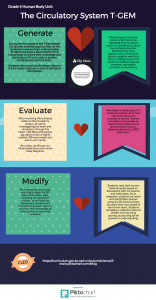To launch the beginning of our units of inquiry in Grade 5, we begin by exploring the big idea of Multicellular organisms have organ systems that enable them to survive and interact within their environment. Before students begin to piece each system together, to understand the interrelatedness we explore each system in isolation, while providing opportunities for students to write and generate questions when hypothesis to connections occur. Students participate in the inquiry cycle by finding out, sorting out, making connections to information. When exploring the form and function of the circulatory system, and the human heart, many students struggle with understanding how oxygenated blood is transported throughout the body, and in particular are often confused by the use of blue blood on models to represent deoxygenated blood. The following 3-Step T-GEM cycle is included below to explain how digital technology supports student understanding.
GENERATE
During the first phase of the T-Gem Model the teacher provides opportunities for the students to express their understanding. Students are given a blank model of the human body to record their knowledge and predictions of the circulatory system, including veins and the heart. Students then watch the Brainpop video on the Circulatory System to record additional information.
Students generate ideas about what they know regarding the circulatory system by labelling the blank human body template. Students then have opportunity to share their ideas in a gallery walk first, then in small groups of 3-4 students. Students discuss, compare, and explain concepts and questions.
EVALUATE
After watching the brainpop video on the circulatory system, as well as investigating the heart and circulatory through the Heart | 3D Atlas of Anatomy app allow to spin a highly realistic 3D heart model as it was in user hands.
As a class, we discuss our initial predictions and human body diagrams.
Working in small groups of 2, students evaluate what they now know about the circulatory system. Teacher circulates and provides an opportunity to discuss and guide student inquiry. Opportunities for the GEM cycle occur.
MODIFY
After exploring the videos, working through the 3D Atlas of Anatomy apps, including the dissection options, as well as class discussions, students are then able to go back and sort out their new knowledge by redoing their human body template.
Students redo their human body template based on discussions with the teacher and classmates. As an extension, students can work with the EdTech teacher using the 3D school printer to create their own model of the human heart. Students complete a reflection piece to solidify their learning journey, accounting for all growth in understanding.

References
Khan, S. (2007). Model-based inquiries in chemistry. Science Education, 91(6), 877-905.
Khan, S. (2010). New pedagogies for teaching with computer simulations. Journal of Science Education and Technology, 20(3), 215-232.
Khan, S. (2012). A Hidden GEM: A pedagogical approach to using technology to teach global warming. The Science Teacher, 79(8). This article was written about T-GEM with middle-schoolers.
HI Cristina,
What an awesome experience for Grade 5 students – especially 3D Anatomy App. In the past I have had students program Sphero to move through the circulatory system on a life-size body drawing. Students really enjoyed that 🙂 Incorporating the 3D modelling would be an amazing experience, and the reflection piece is important to solidify their understanding.
Hi Natalie,
Thank you for your suggestion to use the spheros! We just received some Of these at our school. In the past we would have students actually use real pig hearts to dissect but I personally prefer the 3D models for ethical reasons (especially since the students are so young). Thanks!
Hi Cristina
I like the fact that you brought up group work. This blog article came across my desk today “My Students Don’t Like Group Work“.
I wonder if your grade 5 students feel the same way about group work.
A good next step might be to include citations in your post. You have three references, however, I do not see them in your post.
Christopher
Hi Christopher,
Thanks for the article link! Over the years I’ve experimented with different group dynamics and have found that it has been very beneficial to have similar students grouped together because it gives them the opportunity to play a different role than usual. For example, some lower level students begin to feel confident in likeminded groups and begin to delegate and take on leadership roles that often wouldn’t be their first option. I hope this makes sense, either way it is important for the teacher to have a good grasp of the learning styles of their students as well as the social-emotional needs to effectively scaffold and provide differentiated opportunities. In our Exhibition culminating project student learn to self reflect and identify their strengths to work in a group. Without fail this is often the area that students demonstrate growth in.